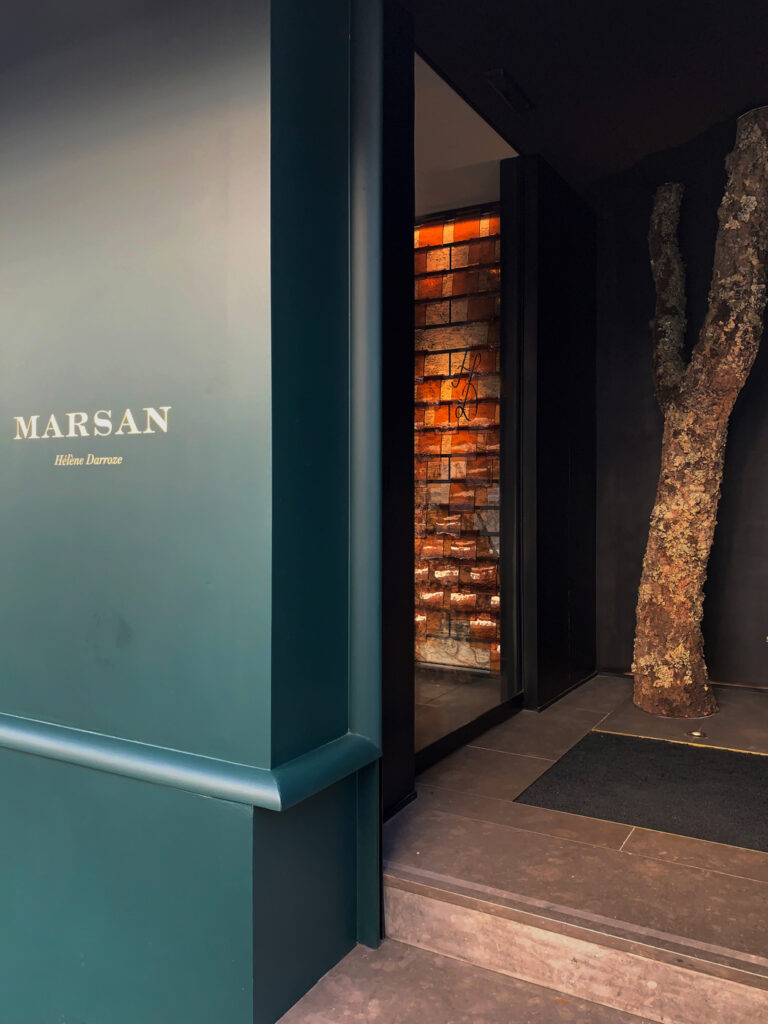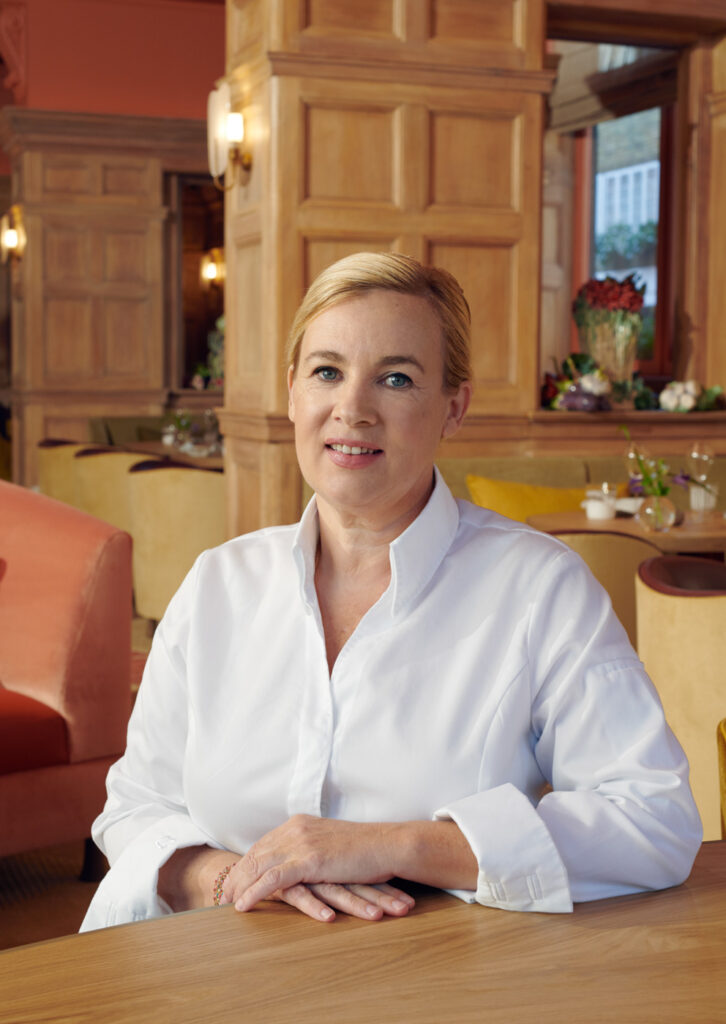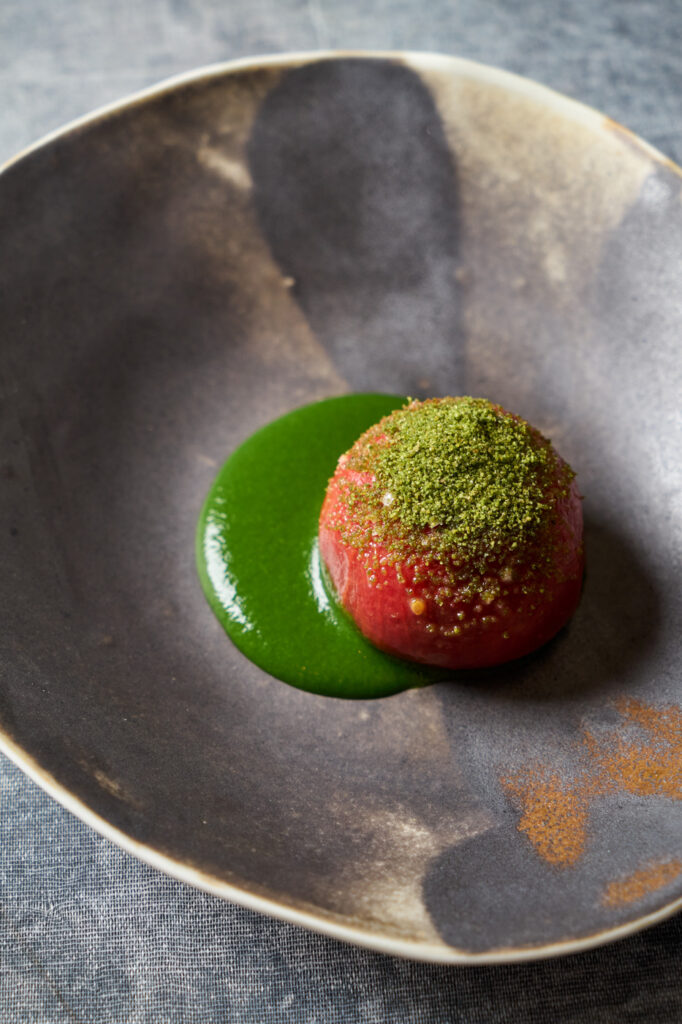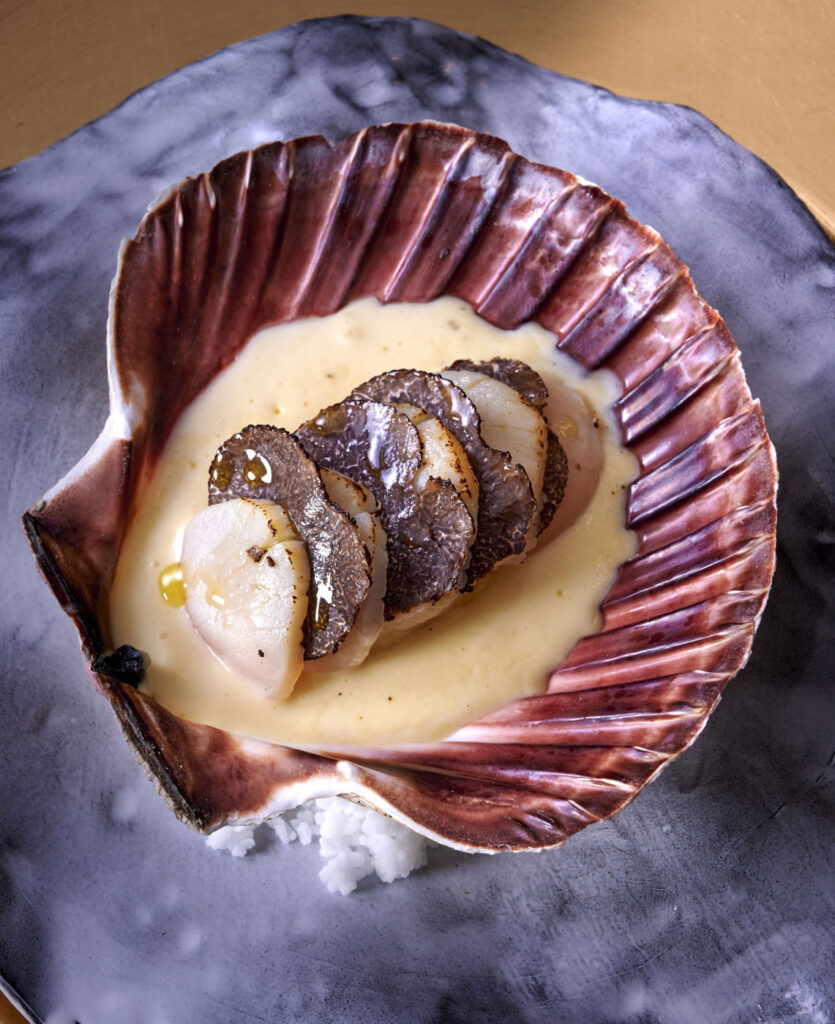Paris — June 2, 2023
A Star in Screen and Guide: Hélène Darroze’s Cuisine D’Auteur
Behind Michelin-starred Chef Hélène Darroze’s ever-present smile is a veritable tour de force of nostalgic flavors and sharp savoir faire.
By EMILY MONACO
Photography by JÉRÔME GALLAND, BERNHARD WINKELMANN, PATRICE GARDERA, JUSTN DE SOUZA

In French, there is a phrase to evoke a flavor memory so ingrained it rockets you back to childhood with a single bite: the madeleine de Proust. A reference to Marcel Proust’s In Search of Lost Time, in which the narrator is sent on a voyage through his own memories via a single bite of a tea-soaked madeleine, it’s perhaps best encapsulated in the modern era in the climax of the Pixar film Ratatouille, when crotchety critic Anton Ego is overcome with childhood memories via a single mouthful of the titular vegetable dish.
Chef Hélène Darroze seeks to deliver a similar sense of nostalgia at her two-Michelin-starred Marsan in Paris’ 6th arrondissement, and no bite encompasses this goal better than a dollop of perfectly seasoned duck fat served simply on a cracker.
“I said to myself: good butter on a slice of bread is very good,” she tells me. “But my culture is duck fat. Everything we eat at Marsan is cooked in duck fat. We sometimes even make pastries with duck fat. So I needed to say it and show it—this is my butter; this is my olive oil.”
With this bite, Darroze is evoking her childhood in Landes, a department in France’s southwest, known for its foie gras, sheep’s milk cheese, and yes, stalwart reliance on duck and goose fat. Ingredients from Landes and the broader French southwest dot the entire menu, from the Espelette pepper-spiked butter, to the ewe-dominant cheese cart, to the Armagnac-doused baba dessert. But it is this bite that encapsulates this terroir—and Darroze’s own nostalgia—at its most essential.
The bite is not just a nod to childhood, however; it is a key to Darroze’s personal culinary approach. It is currently presented to diners as a guessing game. Servers ask clients to guess what they’re eating as they take an untidy nibble. Darroze remains “unconvinced” by this approach, at present; she is still seeking the perfect way to refine the little morsel’s delivery, to best convey the story behind it. Her passion—and perfectionism—evoke yet another way the chef is linked to the Pixar film that so encapsulates the evocative power of food memory: the character of Colette Tatou, known for her zeal and exacting nature, was, after all, inspired by Darroze herself.
“It was such a strange adventure,” she recalls.


That the movie studio and young chef’s paths would cross was a matter of chance. They booked a table at her restaurant during their research phase, and soon after, they were asking to spend time watching her work.
She wasn’t told, at first, that her collaboration would inspire a whole character. “They said they were coming to observe what happened in my kitchens for a few days,” she says. Two years later, “they brought out Colette.”
At that point, Darroze was a new mother; her attention was consumed by her daughter, and she had little time or desire to devote herself to promoting the film. So the film brought promotion to her.
“I remember at 8 a.m.—I was a new mom, and I wasn’t going to leave my baby at 8 a.m.—a French radio station sent a huge recording truck to the tiny street where I lived so I could go downstairs to record,” she says. “That’s when I realized what a big deal it was.”
With her flaxen hair and eternal smile, Darroze doesn’t seem to resemble glowering, dark-haired Colette. Indeed, she doesn’t see much of herself in the character, who she describes as “hard.” “But she’s a passionate person, a very rigorous person,” Darroze concedes. “I think she is—what I think I am too—someone who knows what she wants.”
She doubles back on herself. She knows what she wants, yes, in terms of values. But not in terms of initial career ambition. She never thought, as a young chef, that she would have four-going-on-five restaurants. She never thought she would appear on eight seasons of France’s Top Chef or earn six Michelin stars or be admitted into the French Legion of Honour.
“Maybe it’s not ambition, but I know what I believe in,” she says. “I know what I want, and I think Colette knows too.”


Darroze might not have imagined the extent to which her career would explode, but she was perhaps always destined for kitchens. The fourth generation in a long line of restaurateurs, Darroze came of age working alongside her father at Le Relais, which her great-grandfather opened in 1895 in Villeneuve-de-Marsan—the village to which she owes the name of her Michelin-starred Parisian establishment. Whether working in the family restaurant or cooking alongside her mother at home, she characterizes cooking and food as being her roots, her DNA, which make her who she is today.
“I had a great aunt who had a little inn, and I remember she made these extraordinary dishes of absolute simplicity,” she says. “I remember this jam omelet that was just nuts.”
She looks off into the distance, as though struck doubly by her own recollection.
“We should do something with that,” she says, mostly to herself.
Despite taking her inspiration from childhood flavors, however, Darroze resists being pigeonholed.
“I would say my cuisine is based on southwestern products,” she says, carefully. “I think it’s very personal. Any time anyone has identified me as a cook of southwestern cooking, I’ve kind of opposed it, because I don’t think I cook southwestern food. I think I cook food that’s inspired by southwestern culture and southwestern products, but really, it’s what I would call cuisine d’auteur—a cuisine that’s very, very personal to me.”
When crafting her menu, Darroze begins with instinct: a voyage or a nugget of a memory, like the jam omelet I half-expect to turn up in six months in fine-dining form at Marsan. Some dishes do tap into her roots—she’s currently hard at work concocting a one-bite iteration of a Basque roast porcini mushroom, foie gras and egg yolk dish. But others are born of her travels. Tandoori seafood appears across all of her addresses, with a lobster version featured on the Marsan menu. It’s a combination inspired by a formative voyage to India. Le Retour de Hanoi—Return from Hanoi—is another recurring favorite: a richly spiced, pho-adjacent broth inspired by a life-changing trip to Vietnam.
“I’m mom to two adopted little girls,” she says. “On my first trip, when I went to get Charlotte, behind the hotel where I was, there was this little street food dive where you could get this extraordinary pho.” When she got home, she revisited the dish, swapping the chicken for seafood and serving it with a citrus compôte. It became a star of her menu.
“Every time I travel, something comes out of that trip,” she says. “Every time I talk to a chef, every time I meet someone—you nourish yourself with what you live and who you meet. I think that’s cuisine.”
Despite taking inspiration from such encounters, the chef maintains that her muse comes to her best when she’s alone.
“I start with a blank page,” she says. “What I prefer though, alas, I don’t always have the time anymore. It’s to lock myself at home with a big pair of socks and pajama pants, and I work like that, alone, in front of my blank page.”
Her deep reflection and hard work result in dishes that remain light-hearted—a true reflection of Darroze, a self-professed “natural optimist.” Scallops are served buried beneath a perfect julienne of apples and radishes arranged in a tumble. Cuttlefish’s deep black ink sauce and stark white rice purée are swirled in a balance almost too pretty to eat. The butter she has crafted in close collaboration with her cheesemonger is spiced with Basque Espelette pepper served in its own earthenware cave.
Then, of course, there’s that duck fat bite: an offering almost mischievous in its unfamiliar yet welcome playfulness. When I tell her this, she grins.
“Cooking isn’t technical; it’s emotional,” she says. “That’s how I see it, anyway.”






Our comments section is for members only.
Join today to gain exclusive access.